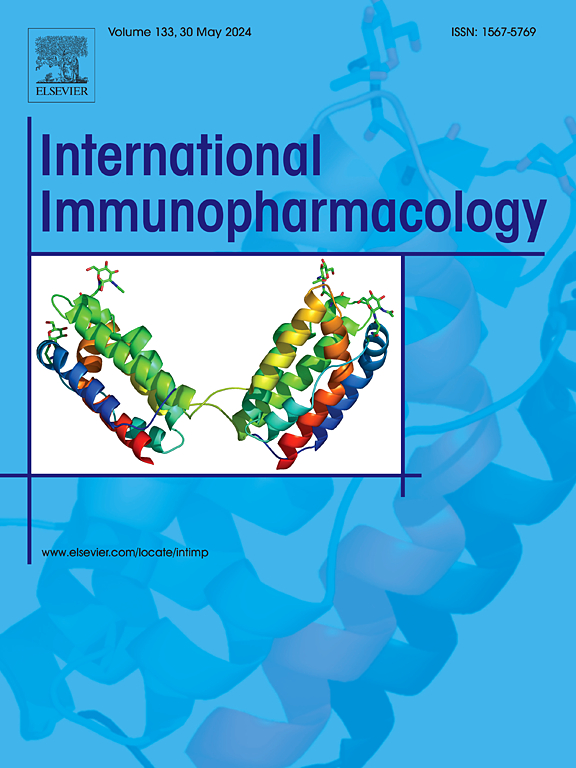Effects of dioscin from Dioscorea nipponica on TL1A/DR3 and Th9 cells in a collagen-induced arthritis mouse model
IF 4.8
2区 医学
Q2 IMMUNOLOGY
引用次数: 0
Abstract
Rheumatoid arthritis (RA) is a systemic autoimmune disease, and TL1A and its receptor DR3 play important roles in its pathogenesis. Th9 cells are involved in RA development. Dioscin from Dioscorea nipponica (DDN) has a therapeutic effect on RA, but its effect on TL1A/DR3 and Th9 cells remains unclear. A collagen-induced arthritis (CIA) model was established in DBA/1 mice, and the therapeutic effects of DDN were determined using pathological sections and arthritis index scores. Western blotting and PCR were used to detect TL1A, DR3, PU.1, TGF-β and IRF-4. Enzyme-linked immunosorbent assay was used to detect the expression of TL1A and IL-9 in the serum. Immunofluorescence was used to detect the localization and expression of TL1A, DR3, and PU.1 in synovial tissue. Flow cytometry was used to detect TL1A and DR3 expression in different immune cells and Th9 cells. DDN ameliorated bone destruction, inflammatory cell infiltration, synovial inflammation, cartilage tissue destruction, and proteoglycan loss. DDN downregulated TL1A, DR3, and PU.1 in the synovium of the lymph nodes and spleen and TL1A and IL-9 in the serum. DDN decreased the number of TL1A-expressing APCs and macrophages, DR3-expressing CD4 + T cells, and Th9 cells. Th9 cell differentiation-related factors TGF-β and IRF-4 were also inhibited by DDN. We conclude that DNN inhibited the expression of TL1A/DR3 in CIA mice and suppressed the expression of the Th9 cell-specific transcription factor PU.1, Th9 cell number, and IL-9 secretion. DDN inhibited the function of Th9 cells by targeting TGF-β and IRF-4 in the TL1A/DR3 pathway, thereby reducing inflammation.

在胶原蛋白诱导的关节炎小鼠模型中,薯蓣皂苷对 TL1A/DR3 和 Th9 细胞的影响
类风湿关节炎(Rheumatoid arthritis, RA)是一种全身性自身免疫性疾病,TL1A及其受体DR3在其发病机制中起重要作用。Th9细胞参与RA的发展。Dioscorea nipponica (DDN)薯蓣皂苷对RA有治疗作用,但其对TL1A/DR3和Th9细胞的作用尚不清楚。建立DBA/1小鼠胶原诱导关节炎(CIA)模型,采用病理切片和关节炎指数评分法测定DDN的治疗效果。Western blotting和PCR检测TL1A、DR3、PU.1、TGF-β和IRF-4。采用酶联免疫吸附法检测血清中TL1A和IL-9的表达。采用免疫荧光法检测滑膜组织中TL1A、DR3和PU.1的定位和表达。流式细胞术检测TL1A和DR3在不同免疫细胞和Th9细胞中的表达。DDN改善骨破坏、炎症细胞浸润、滑膜炎症、软骨组织破坏和蛋白聚糖损失。DDN下调淋巴结和脾脏滑膜的TL1A、DR3、PU.1及血清中的TL1A、IL-9。DDN降低了表达tl1a的apc和巨噬细胞、表达dr3的CD4 + T细胞和Th9细胞的数量。Th9细胞分化相关因子TGF-β和IRF-4也受到DDN的抑制。我们得出结论,DNN抑制了CIA小鼠TL1A/DR3的表达,抑制了Th9细胞特异性转录因子PU.1的表达、Th9细胞数量和IL-9分泌。DDN通过靶向TL1A/DR3通路中的TGF-β和IRF-4抑制Th9细胞的功能,从而减轻炎症。
本文章由计算机程序翻译,如有差异,请以英文原文为准。
求助全文
约1分钟内获得全文
求助全文
来源期刊
CiteScore
8.40
自引率
3.60%
发文量
935
审稿时长
53 days
期刊介绍:
International Immunopharmacology is the primary vehicle for the publication of original research papers pertinent to the overlapping areas of immunology, pharmacology, cytokine biology, immunotherapy, immunopathology and immunotoxicology. Review articles that encompass these subjects are also welcome.
The subject material appropriate for submission includes:
• Clinical studies employing immunotherapy of any type including the use of: bacterial and chemical agents; thymic hormones, interferon, lymphokines, etc., in transplantation and diseases such as cancer, immunodeficiency, chronic infection and allergic, inflammatory or autoimmune disorders.
• Studies on the mechanisms of action of these agents for specific parameters of immune competence as well as the overall clinical state.
• Pre-clinical animal studies and in vitro studies on mechanisms of action with immunopotentiators, immunomodulators, immunoadjuvants and other pharmacological agents active on cells participating in immune or allergic responses.
• Pharmacological compounds, microbial products and toxicological agents that affect the lymphoid system, and their mechanisms of action.
• Agents that activate genes or modify transcription and translation within the immune response.
• Substances activated, generated, or released through immunologic or related pathways that are pharmacologically active.
• Production, function and regulation of cytokines and their receptors.
• Classical pharmacological studies on the effects of chemokines and bioactive factors released during immunological reactions.

 求助内容:
求助内容: 应助结果提醒方式:
应助结果提醒方式:


